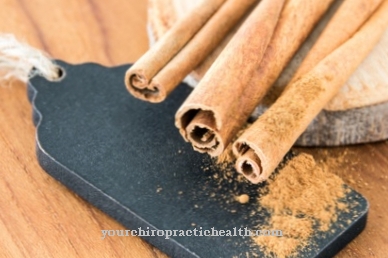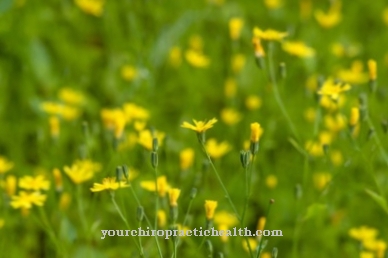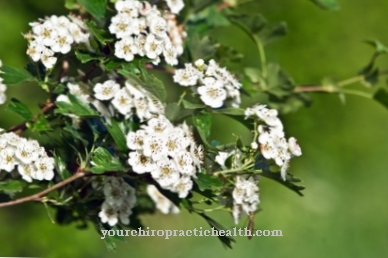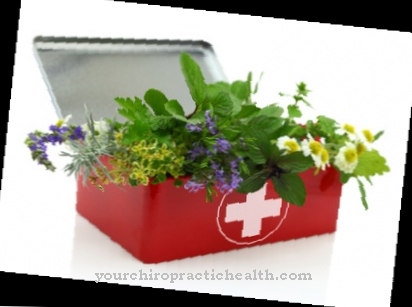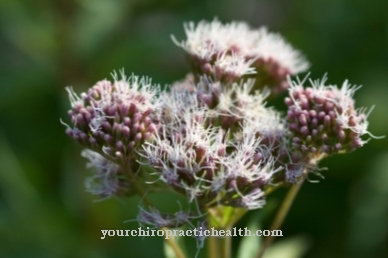Of the Hawthorn occurs almost exclusively in the northern hemisphere. Its many hundreds of genera grow in the temperate climates of Europe, Asia and North America.
Occurrence & cultivation of hawthorn

Only three species of hawthorn are known in Germany. Of the Hawthorn grows as a shrub or tree that can reach a height of around 12 meters. Its flowers are white to deep pink and its growth is gnarled.
The wood of the hawthorn is extremely hard, which is also reflected in its botanical name "Crataegus", because this Latin word means "hard". In some German-speaking regions, the hawthorn is also called flour thorn or whitebeam tree.
The bright red fruits of the hawthorn have a flour-like taste and are also known as white berries. The hawthorn can reach an age of several hundred years.
Application & use
Numerous legends entwine around the Hawthorn. Among the Vikings and Celts it was even said to have magical powers and if someone was covered with a sleeping spell, then the hawthorn, also called sleeping thorn in Nordic, was suspected to be the trigger.
Even the thorns on which Sleeping Beauty pricked and then fell into a hundred-year sleep are said to have come from a hawthorn bush. In fact, the hawthorn has many healing powers that were recognized early on by various peoples. The healing powers of this plant in diseases of the heart, nerves and circulation have already been reported in old herbal books.
Ever since the New York Medical Journal reported its findings regarding the beneficial effects of hawthorn extracts in angina pectoris in 1896, they have been used more and more to treat such diseases. The hawthorn was soon also called the "valerian of the heart".
Scientific studies have meanwhile shown that the ingredients of the hawthorn have a blood circulation-promoting and vascular effect.
Even the Federal Office for Medicinal Products stated that the extract from the plant components of the hawthorn has a positive effect on the conduction of excitation and the contraction of the heart. The vascular resistance is reduced and the blood flow to the heart muscle is promoted. The heart is strengthened, its stimulus threshold is increased and cardiac arrhythmias are alleviated.
Responsible for all these health-promoting effects of the hawthorn are primarily the ingredients called oligomeric proanthocyanidins, as well as flavones and rutin. The first-mentioned substances are known to gently strengthen the heart and improve its supply of oxygen. Since the effect of the hawthorn is always somewhat delayed, it is more tolerable for many people than other drugs.
Significance for health, treatment & prevention
Traditionally, the fruits and flower-bearing branches of the Hawthorn used for the production of medicines. The hawthorn is already known as a medicinal plant in classical Chinese medicine and among various Indian tribes in North America.
Its areas of application include gout, diarrhea and nervousness, among others. It can be used as a tea, as a bath additive, as a tincture or as a poultice. It has a calming effect and is used in natural medicine in the treatment of the elderly heart, high blood pressure, cardiac arrhythmias and circulatory disorders. Modern pharmaceutical hawthorn products are approved in Germany for the treatment of mild heart failure.
Homeopathic remedies made from hawthorn are also known. The older heart, in particular, is no longer able to contract, to contract, as it should. Thus, the blood circulation and the circulation of the entire body is disturbed. Hawthorn gently supports the heart in its task and thus gets the whole body going again.
It has also been proven that the hawthorn keeps the stress hormone norepinephrine away from the heart and thus spares and protects it. Stress-related heart complaints such as heart pounding, palpitations or fluttering heart are alleviated and fought with the help of preparations made from hawthorn.
The hawthorn has been an integral part of modern medicine for a long time and can usually be safely used even over a longer period of time, because side effects such as rashes or gastrointestinal complaints are only known to some specially predisposed people.
You can find your medication here
➔ Medicines for cardiac arrhythmias

